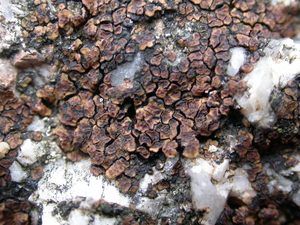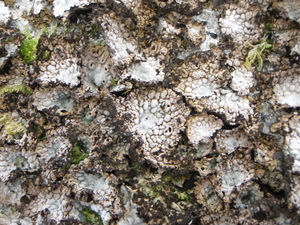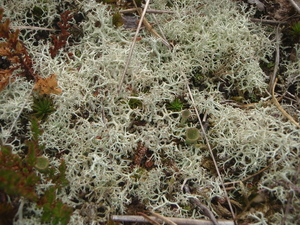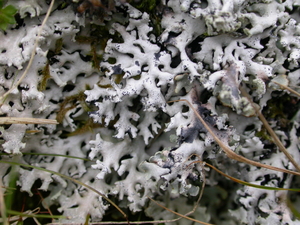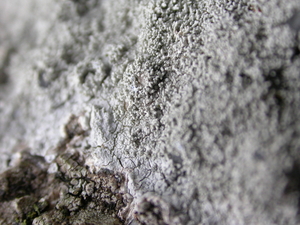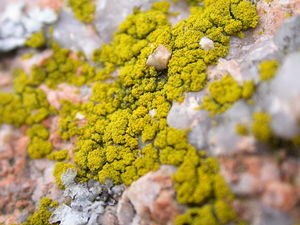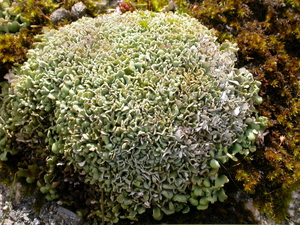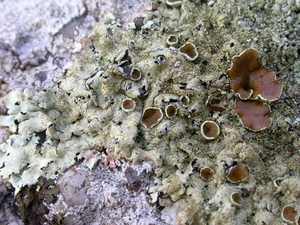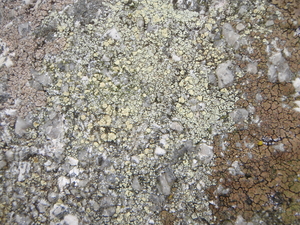I started walking Dartmoor in 1976 and remember that even then I vaguely noticed the range of small organisms under my feet and on the rocks. Some time in my twenties I read articles describing the range of moss and lichen species present, but didn’t really have the time to look at them on the ground, and it is only in the last couple of years that I’ve started to attempt to recognise the common species.
Lichens are certainly challenging, and I’m still a beginner, but was inspired earlier in the year by the FSC one day course at Juniper Hall led by the great David Hawksworth. Since then, I’ve been plodding through the books,[1] and Alan Silverside’s amazing web site, as well as using the FSC laminated guides and any other sources I can find that might tell me what species are known from a particular habitat where I might be looking. So, for Dartmoor, another useful starting point is the survey of the lichens on the rocks, boulders and tors that was conducted in the 1990s,[2] plus the list included in the old Dartmoor New Naturalist.[3]
This survey covers some of the common species found on the granite, starting off with the more abundant ones on the clitter below Trowlesworthy Tor. I’ve still not started using the common reagents to help identify species; ironically, I had prepared some to take with me this time but left them on my desk. Many of these were identified for me by other iSpot users, for which many thanks.
The first batch were the brown crusts of Acarospora fuscata (which the bleach test should briefly turn red), the lovely purply-brown nets of Parmelia omphalodes with its white markings (pseudocyphallae), the white crusts and brown-tipped isidia of Pertusaria pseudocorallina, and the small and exquisite patterning of Rhizocarpon geographicum.
After the small-scale, tiny universe of those boulders, finding Lasallia pustulata nearby was almost akin to stumbling on an elephant, and the distinctive tufts of Cladonia portentosa on the rocks and the ground were familiar to me from the Ashdown Forest heath.
Then, on the rocks nearer the top of the tor I found some Hypogymnia physodes, which I often see in my local Sussex woods, and another white crust, this time Pertusaria corallina, which has the white coral-like isidia, in contrast to P. pseudocorallina.
On more prominent exposed rock were patches of the yellow Candelariella coralliza made up of tightly-packed granules. This was on a prominent large worked stone on the way between the two Trowlesworthy tors:
Trowlesworthy was one of the survey sites included in the paper by Giavarini, who recorded 76 species there in 1990, so my nine is just the tip of the iceberg. It is certainly a rich environment, with various other Cladonias, crusts and other species colonising different habitats: vertical rock faces; wetter areas; sheltered shady spots; and more.
I started to get my eye in for those species when we went up Cox Tor in the fog, and also remembered Cladonia subcervicornis, with its distinctive cushion of squamules. Another common lichen on many of the rocks near the top of the tor was one that I initially thought was a Cladonia, but which turned out to be Stereocaulon vesuvianum. Over on iSpot, Nigel Chadwick helpfully noted that it has greenish soralia and that the dark-centred phyllocladia on largely erect or decumbent pseudopodetia are diagnostic.
Many of these were also in evidence on the Dewerstone a couple of days later, where I also found some fruiting Xanthoparmelia conspersa. with its yellow/green/grey thallus.
Finally, here’s one from a walk last year, near Duck’s Pool. Alan Silverside identified it for me as Lecanora polytropa and noted its “creamy yellow apothecia on a rather dispersed thallus. No soredia.”
The big test, of course, will be how many of these I remember when I’m next visiting the granite…
[1] Dobson, Frank S. Lichens: An Illustrated Guide to the British and Irish Species. Slough: Richmond Publishing, 2011; and Whelan, Paul. Lichens of Ireland. Cork: The Collins Press, 2011.
[2] Giavarini, V.I. “Lichens of the Dartmoor Rocks.” Lichenologist 22:4 (1990): 367-396. Web. <http://dx.doi.org/10.1017/S0024282990000421>. Available from: <http://nhm2.uio.no/botanisk/lav/RLL/PDF2/Lichenologist/22/22_367-396.pdf>.
[3] Harvey, L.S. and D. St Leger-Gordon. Dartmoor. Fontana: London, 1974. 95-97. The New Naturalist Library.




















